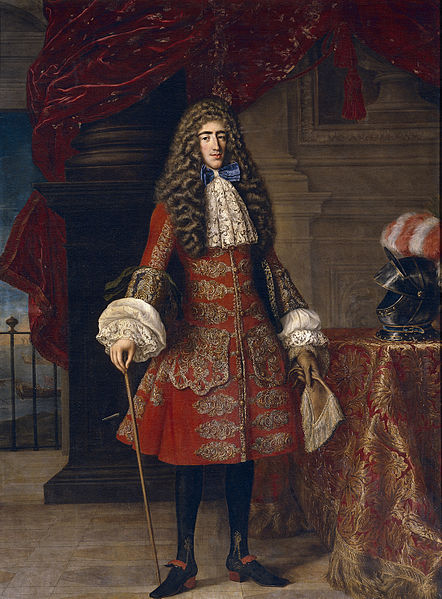 In the late 17th century in Europe, there appeared a lovely men’s ornate coat called a “justacorps”. It looked a lot like Eastern long jackets worn in India, Persia, and Ottoman Empire. But how so? How did Eastern fashion come to France and England, and did it really influence our modern fashion all that much? Is it true that the justacorps was the predecessor of the men's 3-piece suit we use today? Let’s find out.
In the late 17th century in Europe, there appeared a lovely men’s ornate coat called a “justacorps”. It looked a lot like Eastern long jackets worn in India, Persia, and Ottoman Empire. But how so? How did Eastern fashion come to France and England, and did it really influence our modern fashion all that much? Is it true that the justacorps was the predecessor of the men's 3-piece suit we use today? Let’s find out.
A justacorps or justaucorps is a fashionable men’s coat popular in the late 17th – 18th century. It’s a knee-length garment, usually worn as a component of a 3-piece ensemble (breeches + justacorps + long vest or waistcoat). The justacorps originated from France but it gained popularity in Britain and other European countries as well. This item of clothing was especially beloved by the royal and high-status men.
Where did justacorps come from?
In 1666, King Charles II of England revolutionized men's fashion by introducing a new garment called a vest or waistcoat. This knee-length vest was worn with breeches and an overcoat of equal length, which was referred to as a justacorps or cassock because it resembled the vestments worn by priests. This outfit is considered to be the predecessor of the modern-day men's 3-piece suit. By the 1670s, King Charles II began to adopt French fashions, and this trend quickly spread to the English public.
A similar Persian coat with floral embroidery and a tight-fitting body and sleeves probably served as the model for the justacorps. Such folk garments as the achkans and sherwanis, similar coats worn in India for centuries, also had an influence on the design of the European justacorps. Wealthy travelers who visited the East during the early 1600s often wore these coats, and some may have been brought back to England.
Another garment that became popular in Poland and Hungary at the same time was the zupan or dolman, featuring distinctive turn-back cuffs and decorative gold braid. Originally a long and heavy winter gown, the zupan became shorter and more fitted during the 1500s. These Polish garments, including the kontusz and zupan, were also inspired by Oriental influences.
The long coats from Central Europe and India likely influenced the design of the justacorps, which later became favored by King Louis XIV of France and King Charles II due to their exotic appearance, comfort, and practicality.
Justacorps in Europe in the 17th century
Although the justacorps appeared in Europe as early as 1666, it did not become popular until around 1680 when it replaced the shorter, previously popular style of coat known as the doublet. The justacorps was knee-length and worn over an equal-length vest and breeches. It featured a center front opening with many buttons and buttonholes lining the entire length. The sleeves were fitted with deep cuffs, and some versions had a flared skirt through the addition of gores and pleats.

Portrait of Don Luis de la Cerda, later IX Duke of Medinaceli (1654–1711) by Jacob Ferdinand Voet, circa 1684. You can see his ornate masterpiece of a justacorps. Photo from Wikipedia.org
The justacorps coats were often made of luxurious fabrics such as colorful silk, satin, brocade, damask, and wool. They were very ornate in design, with contrasting fabrics of different colors and patterns used for turned-back cuffs or decorative sashes worn across the shoulders. Decorative pockets were also a common feature, although often placed too low for functional use.
The justacorps was primarily worn by aristocratic and wealthy men, and its ornate design reflected its status as a symbol of wealth and prestige. By the early 18th century, the silhouette of the justacorps had become wider, with a fuller skirt, laying the foundation for men's fashion throughout the rest of the century.
Justacorps in Europe in the 18th century
In the 1st half of the 18th century, the justacorps underwent several changes in appearance. The garment's center front opening remained, but the buttons only extended to the waist area, allowing for a fuller skirt. The cuffs became tighter and functional pockets were moved to a more accessible hip-level area. The opening of the coat was rounded towards the mid chest, and flared away from the body.
In the 2nd half of the 18th century, the justacorps skirt decreased in fullness, becoming narrower. The rounded opening was replaced with a straight edge similar to the 17th-century-style openings, and sleeves reverted to a deep, turned-back cuff. These fashionable coats were made of a variety of textiles depending on their use. Wool was commonly used in ordinary everyday situations and typically had less ornamentation than those worn in formal settings, which were made of ornate fabrics (silk and brocade), and often decorated with elaborate embroidery and lace.
It's important to distinguish the justacorps from the frock coat, which was less ornate, had a different cut and silhouette, and was not popular until the late 18th century.


